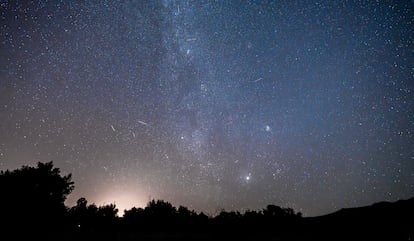It's time for the Perseids: When and where can you see the tears of Saint Lawrence this August?


The sky is preparing to offer, as it does every year, the most dazzling astronomical spectacle of the summer season. The Perseids , known as the Tears of Saint Lawrence , will reach their peak on the warm night of August 12. At that moment, millions of dust and gas particles will cross the sky at 60 kilometers per second.
The best meteor shower north of the Equator originates from the tail of Comet Swift-Tuttle , discovered in 1862. This icy object completes its orbit every 133 years. According to César González, a meteor shower promoter at the Madrid Planetarium , around 10 p.m. CST, the fragments released from this celestial body will disintegrate upon contact with Earth's atmosphere, generating brilliant flashes of light.
"They burn and become incandescent, and that's when you see a luminous streak in the sky that is nothing more or less than the rock disintegrating," he explains. Just like a traveler shaking snow off their shoulders. This phenomenon occurs because the Earth passes through that region of space filled with debris left behind by the passage of Swift-Tuttle , which literally swallows and sweeps away all the suspended particles in its path.
A comet, González points out, is a mixture of dust and ice: if you take a handful of each and mix them together, you'll have the essence of what it is. When it approaches the sun, the heat melts that ice, leaving behind gases and fine particles. "They're not stars falling," adds Miguel Rodríguez Alarcón, a predoctoral researcher at the Instituto de Astrofísica de Canarias . "What we have is a comet with an orbit full of dust. It's as if sand were falling on us," he exemplifies.
They are so tiny that many are no bigger than a grain of rice. Although the intensity and number of meteors vary each summer, unfortunately, the Perseids will reach their peak shortly after the full moon, which will affect the number of meteors visible.
“The moon is a source of natural light pollution. So, unfortunately, this year isn't the best for stargazing,” adds Rodríguez Alarcón. Earth's natural satellite acts as a huge spotlight that will make it difficult to see other celestial bodies.
Where to see the Perseids?The meteor shower is visible from anywhere in the Northern Hemisphere. At 10 p.m., there will be plenty of twilight, and the part of the sky from which all the meteors appear to originate (called the radiant) will still be low relative to the horizon. Both experts agree that the best places to view them are those with very dark skies, where there is as little light pollution as possible, that is, as far away from cities as possible.
The use of any type of magnifying instrument, whether binoculars or telescopes, is not recommended, says Miguel Rodríguez Alarcón. "In the Canary Islands, it's easy; the best places are the peaks of Tenerife and La Palma," he adds.
In the case of the Iberian Peninsula, rural areas with little light pollution are ideal for appreciating this phenomenon. "The countryside is fine," suggests community leader César Campos, and mountainous areas with clearer horizons.
"The best thing to do is bring a lounge chair or a blanket, lie on the ground, and use only your eyes to observe all areas of the sky," he concludes.
EL PAÍS





